COLD FLOW NUMERICAL ANALYSIS OF GAS MICROTURBINE COMBUSTION CHAMBER THROUGH CFD TOOL
DOI:
https://doi.org/10.5380/reterm.v18i1.67044Keywords:
CFD, gas turbine, combustion chamber, numeric simulationAbstract
Gas turbines are equipment used mainly in the generation of electric energy. They have as one of their main components the combustion chamber. Therefore, it is relevant to study the characteristics of this component, in order to reach a satisfactory operation. In this context, this paper presents an analysis of a combustion chamber applied to a gas turbine with a cold flow approach using the numerical theoretical method, through the computational fluid dynamics technique. In this experiment, the software Abaqus CFD (computational fluid dynamics) – present in the 3DExperience platform – and the finite volume method are used. The objective was to evaluate the flow, pressure and velocity profiles during the single-phase flow. The gas turbine prototype is configured using a combustion chamber of reverse flow type in order to decrease flow velocity and increase the combustion efficiency. Based on input data obtained from practical experiments, the calculation of the number and Reynolds confirmed – according to the literature of fluid mechanics – the occurrence of a flow classified as turbulent, with chaotic and random motion, what allows defining the ideal point of injection from analysis of velocity plots with stream lines. In addition, a Mach number smaller than 0.3 confirms the theory of having an incompressible flow, in which compressibility effects can be disregarded. The analysis of mass flow rates of the combustion zones made it possible to evaluate maximum differences of 3% between the design data and the one found in the study. To determine the inherent error of the mesh in the CFD study was calculated through the grid conference method, the value found was around 2.68%.
Downloads
Published
How to Cite
Issue
Section
License
Direitos Autorais para artigos publicados nesta revista são do autor, com direitos de primeira publicação para a revista. Em virtude da aparecerem nesta revista de acesso público, os artigos são de uso gratuito, com atribuições próprias, em aplicações educacionais e não-comerciais.



